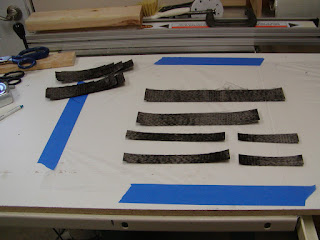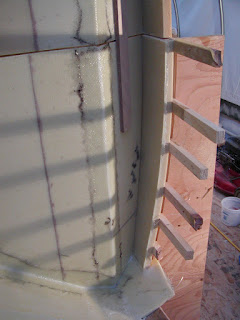I decided to produce another bow web. This is my third one, and I think I'm getting better at it. :) I delayed posting any details about it until it was basically complete, so I could get it all in one post. Much of this info has already been posted (on this blog or elsewhere), but I figured I'd write it all up since I had the pictures anyway. Hope it's helpful to someone.
New foam blank, with high-density pieces ready to glue in:
 After tapering the upper portion of the web on the table saw, I glue the G10 tube on top (btw, make sure you sand the G10 til rough - it's smooth when new and I don't trust it):
After tapering the upper portion of the web on the table saw, I glue the G10 tube on top (btw, make sure you sand the G10 til rough - it's smooth when new and I don't trust it):
 After that cures, I sand it smooth and get ready for the initial wrap of C glass:
After that cures, I sand it smooth and get ready for the initial wrap of C glass:
 You can obviously tell where that piece of glass is going to go. Not shown but done at the same time as the above piece was the extra 3" piece of C over the tube.
You can obviously tell where that piece of glass is going to go. Not shown but done at the same time as the above piece was the extra 3" piece of C over the tube.
Back when I initially started the project I ordered five yards of DB glass (w/o mat) from Noahs, thinking that this would be easier to use than rotating BD glass 45 degrees. The DB glass was a disappointment -- it was extremely fragile and hard to use; I would not recommend using it.
After that cures and gets cleaned up (stray glass cut or sanded away), it's time to do the rest of the bare edges. Here's the bottom wrap going on:
 After applying peelply:
After applying peelply:
 I've struggled to get glass to wrap and stick around curved edges like this. One thing that seems to help, is putting a very thin layer of bog over the curve and the nearby foam\glass, right before wrapping the glass around the curve. The bog seems to act as a nice filler layer between the previous layer and the new glass, helping it to stick nice and tight and filling in any potential voids.
I've struggled to get glass to wrap and stick around curved edges like this. One thing that seems to help, is putting a very thin layer of bog over the curve and the nearby foam\glass, right before wrapping the glass around the curve. The bog seems to act as a nice filler layer between the previous layer and the new glass, helping it to stick nice and tight and filling in any potential voids.
Similar procedures were used to wrap the front and rear edges of the bow web - I use multiple narrow pieces of peelply on the sharply curved sections, since peelply doesn't stretch and conform too well in those areas.
I bagged on the straight layers of carbon fiber:
 For my second bow web, for some reason I thought I had ran out of the "good" carbon fiber, i.e. the nice Hexcel product I ordered from Ian at the beginning of the project. So I ended up using a lighter weight of carbon fiber, which had to be tripled-up to get the minimum weight, which partially accounts for the chunkiness of that bow web. (I tossed out my first bow web attempt before ever getting to the carbon fiber stage. :) Turns out I still had some of Ian's carbon fiber hiding on a shelf; had barely enough left to do the rest of the bow web, but this did require some edge-butting, hence the narrow double pieces here:
For my second bow web, for some reason I thought I had ran out of the "good" carbon fiber, i.e. the nice Hexcel product I ordered from Ian at the beginning of the project. So I ended up using a lighter weight of carbon fiber, which had to be tripled-up to get the minimum weight, which partially accounts for the chunkiness of that bow web. (I tossed out my first bow web attempt before ever getting to the carbon fiber stage. :) Turns out I still had some of Ian's carbon fiber hiding on a shelf; had barely enough left to do the rest of the bow web, but this did require some edge-butting, hence the narrow double pieces here:
 Marking the location of the carbon fiber:
Marking the location of the carbon fiber:
 And curing in front of the fireplace after laminating and peelply are done:
And curing in front of the fireplace after laminating and peelply are done:

If you look closely on the front two carbon layers, you can see that there are five layers there not four -- I had two short pieces of carbon left over, and decided to go ahead and use them on the web.
I really like how things cure nice and fast in front of that fireplace. Mom, thanks again for the candleholders; they're working great!
Here's how the web was looking at that point:
 Next step was filling in between the layers of carbon:
Next step was filling in between the layers of carbon:
 After sanding that down, I was now ready for the final covering of C glass, this is the first layer:
After sanding that down, I was now ready for the final covering of C glass, this is the first layer:
 Those stripes look kinda cool -- like a giant piece of candy or something. :) The two extra layers of glass over the nose ended up making it look a bit bulbous in that area - unavoidable, I guess.
Those stripes look kinda cool -- like a giant piece of candy or something. :) The two extra layers of glass over the nose ended up making it look a bit bulbous in that area - unavoidable, I guess.
After the whole web was done, it was time for slot-cutting. I decided to dado-cut the slots, using a jig I came up with:
 There are actually two metal rods, one from each end of the web, spaced - in this picture - so that there is room to cut the biggest slot which I did first. They are attached to two wood blocks whose hole-centers are precisely 5/8" from the table saw surface (actually, they are the same blocks I used for making the bog-washers for the float chainplates). This setup located the G10 tubing parallel to the saw surface, with the tubing center 5/8" away, so to cut the specified 5/8" depth (below the G10 tube, into the web), I set the blade height at 1 1/4". It was more difficult to get the web vertical to the saw surface -- there are no "known" surfaces on the outside of the web, so I had to eye-ball that part.
There are actually two metal rods, one from each end of the web, spaced - in this picture - so that there is room to cut the biggest slot which I did first. They are attached to two wood blocks whose hole-centers are precisely 5/8" from the table saw surface (actually, they are the same blocks I used for making the bog-washers for the float chainplates). This setup located the G10 tubing parallel to the saw surface, with the tubing center 5/8" away, so to cut the specified 5/8" depth (below the G10 tube, into the web), I set the blade height at 1 1/4". It was more difficult to get the web vertical to the saw surface -- there are no "known" surfaces on the outside of the web, so I had to eye-ball that part.
After the last slot was cut:
 Looking at the cross-sections is fun:
Looking at the cross-sections is fun:
 Next up is making insulating washers\layers (and sealing the foam) out of bog:
Next up is making insulating washers\layers (and sealing the foam) out of bog:
 Tomorrow I'll re-cut the slots to size and then this job is done - will edit this post to add a picture of the final product.
Tomorrow I'll re-cut the slots to size and then this job is done - will edit this post to add a picture of the final product.






















































